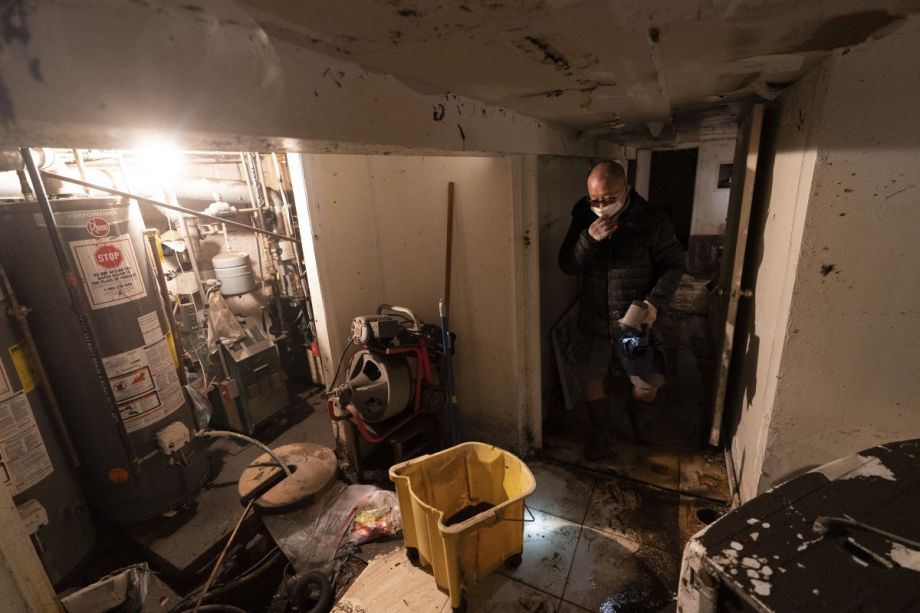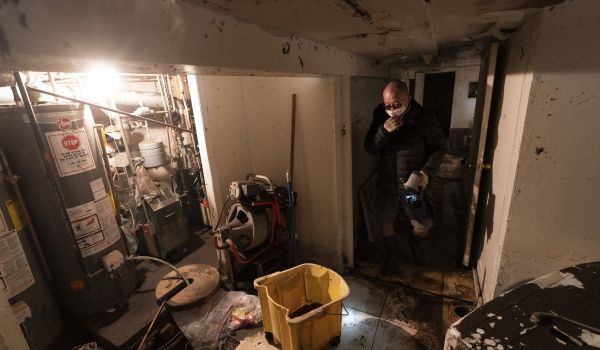In September, the remnants of Hurricane Ida swept the Eastern seaboard, dropping historic rainfall and causing flash floods in New York City neighborhoods. The storm dropped more than three inches of rain onto the city in the span of an hour, a record for the area. 13 people across the city died, 11 of whom were Queens residents residing in illegally converted basement apartments who drowned in their own homes.
The deaths sparked a conversation about the converging housing and climate crises in New York City. In a city that has the highest rents in the nation, many people occupy illegally converted basement apartments. These units have affordable rents, but can carry higher safety risks because they aren’t inspected or necessarily up to code. While exact numbers are hard to pin down, studies estimate there are up to 200,000 illegal basement units across the city, often occupied by immigrants and low-income people. Since 2008, advocates with the BASE Campaign have been pushing the city to fund safety upgrades that would legalize these apartments.
A program that would do just that was finally launched in 2019, but much of its administrative funding was stripped in response to pandemic budget cuts in 2020. Advocates with the BASE Campaign told Next City that even before funding was cut, the city was not supporting the project. The pilot was small, setting out to upgrade 40 buildings in the East New York neighborhood of Brooklyn over the course of three years. But it has only yielded 8 participants so far, according to a Housing Preservation Department spokesman, and none of those conversions are complete.
Moreso, the scope of the pilot did not fully address flooding, focusing instead on fire safety, although additional exits were part of some upgrades. The pilot avoided coastal areas that were part of the city’s “flood maps,” and its single-neighborhood scope did not include areas in Southeast Queens and Western Queens that were impacted by inland flooding that came with Ida.
Before Hurricane Ida, the BASE coalition published a blueprint asking the city to fully support the pilot, including hiring administrative roles and providing grants to community organizations. The blueprint also asked the city to scale the process up citywide and establish a new office to help homeowners navigate the bureaucratic hurdles that come with home conversions.
“They didn’t take it seriously, I think they frankly didn’t think they had to,” says Rebekah Morris, a senior program manager with Pratt Center for Community Development, a partner in the BASE Campaign.
The Basement Apartment Conversion Pilot Project allowed low and middle income homeowners to upgrade an existing basement or cellar to make it fit for habitation and meet city and state regulations. To make the process slightly less expensive and time-consuming, the law also altered regulations for converting a one family home to a two family home.
Homeowners were able to apply for the program and, if chosen, could receive up to $120,000 in low-interest and forgivable loans to fund the upgrades. A local East New York nonprofit, Cypress Hills Local Development Corporation, helped with technical assistance. Participating homeowners were required to allow renters back into the apartment once upgrades were complete, while also keeping the unit at the same rent level as before the upgrades. Chhaya CDC, a non-profit that addresses the housing needs of low-income South Asian and Indo-Caribbean New Yorkers, helped renters to find housing while upgrades were being made, according to Executive Director Annetta Seecharan.
The 2019 legislation was seen as a huge success to members of the BASE Campaign, which includes Chhaya CDC, Cypress Hills LDC and the Pratt Center. But members of the campaign said the city’s enthusiasm and engagement diminished when the challenges began.
“There was a lot of good conversation” when the program began, Pratt’s Morris says. In an email, HPD told Next City that they reached out to 8,000 potential program participants and assessed over 100 households leading up to the pilot.
“And then the real hard work of implementing it began,” Morris says, “and no one wanted to deal with it.”
Morris says that the city didn’t prioritize the program, taking a long time to approve paperwork and failing to walk the program through many bureaucratic hurdles — obstacles that should have been expected given the complex web of city and state regulations at play.
“If you’re given no support, that’s the biggest logistical hurdle,” Morris says. She also said that HPD failed to partner with organizations and advocates who had pushed for the program.
“They weren’t really considered in the program design process,” she says.
Then came the budget cuts. In the city’s 2021 budget, the Basement conversion pilot was drastically cut by over $1 million. When federal stimulus money from the CARES Act buttressed city coffers later that year, the de Blasio administration chose not to re-insert the funding. An HPD spokesperson told Next City that funding for participating homeowner loans remained intact. But an open letter to the City Council from the BASE campaign warned that if cuts remained, the program’s administrative roles would be slashed and the pilot “will no longer be viable.”
The city did release early estimates from the pilot suggesting it would be prohibitively expensive to scale citywide, saying that the cost could run $250,000 to $310,000 per unit. But advocates say these numbers do not present a complete picture. Basements across the city vary widely, and some may be too expensive to upgrade for a variety of reasons including ceiling height. Morris says that claims that the program was too expensive or complicated were premature as the pilot, far from being completed, had barely begun. She says the ultimate cost of the basement conversion pilot was not much money in the scheme of the city’s billions of dollars worth of federal relief funds.
“They can say that it’s very difficult but they haven’t done it yet,” Morris says.
But even if the pilot was on track, it was not initially designed to address the issues that led to deaths after Hurricane Ida. The pilot avoided flood zones, which the city viewed as too risky, restricting East New York residents from within those zones from applying. Even those flood zones merely address coastal flooding, only one aspect of climate-related flooding.
During Ida, the city faced flash floods from stormwater and sewage runoff, a result of the city’s aging combined sewer system, where rain and untreated waste intermix. Queens is especially vulnerable to flash floods because of an infrastructure built around cars, including concrete, asphalt, and other hard surfaces that don’t absorb rainwater, sending water to the sewers. Trees and other green space help to absorb rainwater, but the borough has relatively little.
To make matters worse, many of those who were impacted lived in a part of Southeast Queens built atop marshland, making their buildings particularly vulnerable. A group of Queens homeowners impacted by Ida recently pushed for the city to purchase their homes — something it did for certain Staten Island residents in flood zones after Hurricane Sandy.
The city has made some efforts to fix these infrastructure issues. Mayor Bill de Blasio committed $1.9 billion to a set of improvements in 2018 meant to reduce flooding by replacing sewer mains, but the project was unfinished at the time Ida hit.
In May, the city released a stormwater resiliency plan which highlighted the challenge of mitigating flash flooding. The report seems to confirm that Southeast Queens, where some residents perished in their basements, was among the areas that could fall victim to this flooding. But the report calls for more data. “Inland flooding complaints are prevalent in Southeast Queens and Southern Brooklyn,” the report said. “More information on flood cause and frequency is essential to better prepare for and respond to future emergencies.”
“It’s unlikely that you’re going to be able to stop flooding entirely,” says Timon McPhearson, a professor of Urban Ecology at the New School as well as a member of the New York City Panel on Climate Change. McPhearson says there’s no standard closure that would block off water in basement apartments because of the variety of the apartments.
“It’s going to flow downhill into basements really naturally,” he says. He suggests emergency kits for basement apartment dwellers that include sandbags. Solving the larger problem of flooding, he says, would require a complete infrastructure upgrade that could take several decades and cost hundreds of billions of dollars. It would involve raising curb heights and building underground water storage as well as dramatically increasing the amount of green infrastructure across the city.
But these long-term fixes will not immediately help people living in basement apartments, who number in the tens of thousands across the city. Seecharan, with Chhaya CDC, says all of the information learned since Ida should be factored into the pilot, which should be fully funded and expanded.
“We know that something has to be done, but what exactly, let’s figure it out together. We want to work with the city to figure that out,” she says.
Another complication for the basement pilot is that many people living in basement apartments, as well as homeowners, may not want to go to the city for help and risk legal exposure or eviction. HPD has confirmed that they will issue notices to vacate basement apartments that are not up to code.
In Queens, many basement apartment dwellers are immigrants, some of whom may not have legal status. Often the homeowners they are renting from are also immigrants from within their community.
“The people who need the help are not going to express it to the world,” says Morris. Seecharan says she has not heard anything from the city about the East New York pilot or about expanding basement conversion citywide. Democratic mayoral nominee Eric Adams, who will likely take office in January, has expressed support for basement conversions. (He has also faced accusations that a home he owns holds an illegally converted unit.)
Unless the city addresses the safety of basements and finds a non-punitive way to address homeowners with basement apartments, Seecharan fears the problem will persist. “We’re worried that they’re all going to go right back to renting out their units because they have no choice,” she says, adding that for many low income and middle-income homeowners, renting their basement is the only way for them to pay their mortgages.
Seecharan says even with all the logistical complications and conflicting regulations, leadership at the city and state level to solve the problem has been missing. “It comes down to leadership and commitment,” she says. “it has to happen. We don’t have a choice.”
This article is part of Backyard, a newsletter exploring scalable solutions to make housing fairer, more affordable and more environmentally sustainable. Subscribe to our weekly Backyard newsletter.

Roshan Abraham is Next City's housing correspondent and a former Equitable Cities fellow. He is based in Queens. Follow him on Twitter at @roshantone.


















